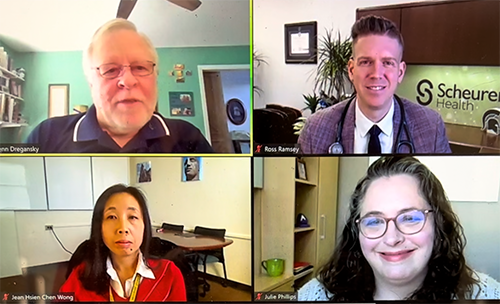| PCP Shortage Worsening |
 |
 |
 |
| Latest News | |||
| Monday, March 20, 2023 02:59 PM | |||
PCP Shortage WorseningFamily Physicians Highlight Alarming Trend During Family Medicine Week
“Seeing your primary care specialist, like a family physician who cares for families and individuals from birth through end of life, leads to better health outcomes, yet there are still too many people without a primary care physician as their regular source of care,” said Dr. Glenn Dregansky, president of Michigan Academy of Family Physicians. “Alarming data shows that 20 percent of adults and 8 percent of children in our state do not visit a primary care physician for routine care like well-child appointments, annual exams, and immunizations. This means too many healthcare needs are unnecessarily being handled by urgent care centers and emergency rooms.” 3M Michiganders Lack Usual Source of CareMAFP and its family physician members held the roundtable during Family Medicine Week, proclaimed by Governor Whitmer as March 19-25, 2023. Currently, only 24 percent of Michigan’s new physician workforce is entering into primary care specialties each year. When it comes to the family medicine specialty, 1 in 8 medical students enter family medicine residencies each year, when a ratio of 1 in 4 is critically needed. “The need for primary care continues to grow and yet we have less and less doctors going into essential primary care specialties like family medicine,” said Dr. Julie Phillips of Michigan State University College of Human Medicine. “Recent studies show more than 3 million Michiganders lack access to primary care and more than 22 percent of hospitalizations in our state are preventable. These are trends we need to reverse quickly or we’ll be in a crisis situation.” The Association of American Medical Colleges estimates there will be a shortage of up to 48,000 primary care physicians in the United States by 2034. In Michigan, we are at a minimum 862 primary care physicians short, according to Robert Graham Center reports. This year’s national Resident Match showed this trend continuing to worsen, as around 557 family physician residency positions remained unfilled. “While the residency Match results reflect some momentum for family medicine, the pace needs to accelerate in order to meet the demand for primary and preventive care,” said Dr. Jean Wong of the University of Michigan. “The U.S. medical education system is far from delivering the primary care medical workforce needed in the country it serves, and whose taxpayers fund it.” Greater Investments in Primary Care Workforce NeededTwo ways this shortage can be addressed at the state level is expansion of the MIDOCs resident physician program and the Michigan State Loan Repayment Program. MIDOCs aims to expand graduate medical education residency positions in primary care specialties while recruiting and retaining physicians in underserved areas of Michigan. More state funding could increase the number of resident physicians being trained to help recruit physicians to primary care specialties and keep them in Michigan. The Michigan State Loan Repayment Program assists employers in recruiting and retaining primary care physicians in underserved communities, by providing medical education loan repayment assistance in exchange for practicing in areas with a health professional shortage. “As the primary care physician shortage worsens, sustained state funding coupled with more investment in MIDOCs and the Michigan State Loan Repayment Program will go a long way in boosting the availability of family physician-led team-based care in our state,” said Dr. Ross Ramsey of Scheurer Health in Michigan’s rural thumb area. “As we celebrate Family Medicine Week, we are seeking essential investments in primary care before the physician shortage worsens and primary and preventive care becomes harder to access.”
|


 A growing primary care physician shortage could soon become a crisis if trends aren’t reversed, Michigan Academy of Family Physicians stressed today during a media roundtable.
A growing primary care physician shortage could soon become a crisis if trends aren’t reversed, Michigan Academy of Family Physicians stressed today during a media roundtable.